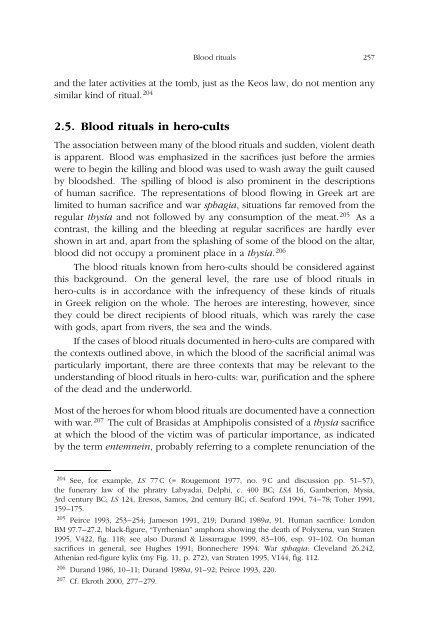The sacrificial rituals of Greek hero cults in the Archaic to the early ...
The sacrificial rituals of Greek hero cults in the Archaic to the early ...
The sacrificial rituals of Greek hero cults in the Archaic to the early ...
Create successful ePaper yourself
Turn your PDF publications into a flip-book with our unique Google optimized e-Paper software.
Blood <strong>rituals</strong> 257<br />
and <strong>the</strong> later activities at <strong>the</strong> <strong>to</strong>mb, just as <strong>the</strong> Keos law, do not mention any<br />
similar k<strong>in</strong>d <strong>of</strong> ritual. 204<br />
2.5. Blood <strong>rituals</strong> <strong>in</strong> <strong>hero</strong><strong>cults</strong><br />
<strong>The</strong> association between many <strong>of</strong> <strong>the</strong> blood <strong>rituals</strong> and sudden, violent death<br />
is apparent. Blood was emphasized <strong>in</strong> <strong>the</strong> sacrifices just before <strong>the</strong> armies<br />
were <strong>to</strong> beg<strong>in</strong> <strong>the</strong> kill<strong>in</strong>g and blood was used <strong>to</strong> wash away <strong>the</strong> guilt caused<br />
by bloodshed. <strong>The</strong> spill<strong>in</strong>g <strong>of</strong> blood is also prom<strong>in</strong>ent <strong>in</strong> <strong>the</strong> descriptions<br />
<strong>of</strong> human sacrifice. <strong>The</strong> representations <strong>of</strong> blood flow<strong>in</strong>g <strong>in</strong> <strong>Greek</strong> art are<br />
limited <strong>to</strong> human sacrifice and war sphagia, situations far removed from <strong>the</strong><br />
regular thysia and not followed by any consumption <strong>of</strong> <strong>the</strong> meat. 205 As a<br />
contrast, <strong>the</strong> kill<strong>in</strong>g and <strong>the</strong> bleed<strong>in</strong>g at regular sacrifices are hardly ever<br />
shown <strong>in</strong> art and, apart from <strong>the</strong> splash<strong>in</strong>g <strong>of</strong> some <strong>of</strong> <strong>the</strong> blood on <strong>the</strong> altar,<br />
blood did not occupy a prom<strong>in</strong>ent place <strong>in</strong> a thysia. 206<br />
<strong>The</strong> blood <strong>rituals</strong> known from <strong>hero</strong>-<strong>cults</strong> should be considered aga<strong>in</strong>st<br />
this background. On <strong>the</strong> general level, <strong>the</strong> rare use <strong>of</strong> blood <strong>rituals</strong> <strong>in</strong><br />
<strong>hero</strong>-<strong>cults</strong> is <strong>in</strong> accordance with <strong>the</strong> <strong>in</strong>frequency <strong>of</strong> <strong>the</strong>se k<strong>in</strong>ds <strong>of</strong> <strong>rituals</strong><br />
<strong>in</strong> <strong>Greek</strong> religion on <strong>the</strong> whole. <strong>The</strong> <strong>hero</strong>es are <strong>in</strong>terest<strong>in</strong>g, however, s<strong>in</strong>ce<br />
<strong>the</strong>y could be direct recipients <strong>of</strong> blood <strong>rituals</strong>, which was rarely <strong>the</strong> case<br />
with gods, apart from rivers, <strong>the</strong> sea and <strong>the</strong> w<strong>in</strong>ds.<br />
If <strong>the</strong> cases <strong>of</strong> blood <strong>rituals</strong> documented <strong>in</strong> <strong>hero</strong>-<strong>cults</strong> are compared with<br />
<strong>the</strong> contexts outl<strong>in</strong>ed above, <strong>in</strong> which <strong>the</strong> blood <strong>of</strong> <strong>the</strong> <strong>sacrificial</strong> animal was<br />
particularly important, <strong>the</strong>re are three contexts that may be relevant <strong>to</strong> <strong>the</strong><br />
understand<strong>in</strong>g <strong>of</strong> blood <strong>rituals</strong> <strong>in</strong> <strong>hero</strong>-<strong>cults</strong>: war, purification and <strong>the</strong> sphere<br />
<strong>of</strong> <strong>the</strong> dead and <strong>the</strong> underworld.<br />
Most <strong>of</strong> <strong>the</strong> <strong>hero</strong>es for whom blood <strong>rituals</strong> are documented have a connection<br />
with war. 207 <strong>The</strong> cult <strong>of</strong> Brasidas at Amphipolis consisted <strong>of</strong> a thysia sacrifice<br />
at which <strong>the</strong> blood <strong>of</strong> <strong>the</strong> victim was <strong>of</strong> particular importance, as <strong>in</strong>dicated<br />
by <strong>the</strong> term entemne<strong>in</strong>, probably referr<strong>in</strong>g <strong>to</strong> a complete renunciation <strong>of</strong> <strong>the</strong><br />
204 See, for example, LS 77 C (= Rougemont 1977, no. 9 C and discussion pp. 51–57),<br />
<strong>the</strong> funerary law <strong>of</strong> <strong>the</strong> phratry Labyadai, Delphi, c. 400 BC; LSA 16, Gamberion, Mysia,<br />
3rd century BC; LS 124, Eresos, Samos, 2nd century BC; cf. Seaford 1994, 74–78; Toher 1991,<br />
159–175.<br />
205 Peirce 1993, 253–254; Jameson 1991, 219; Durand 1989a, 91. Human sacrifice: London<br />
BM 97.7–27.2, black-figure, “Tyrrhenian” amphora show<strong>in</strong>g <strong>the</strong> death <strong>of</strong> Polyxena, van Straten<br />
1995, V422, fig. 118; see also Durand & Lissarrague 1999, 83–106, esp. 91–102. On human<br />
sacrifices <strong>in</strong> general, see Hughes 1991; Bonnechere 1994. War sphagia: Cleveland 26.242,<br />
A<strong>the</strong>nian red-figure kylix (my Fig. 11, p. 272), van Straten 1995, V144, fig. 112.<br />
206 Durand 1986, 10–11; Durand 1989a, 91–92; Peirce 1993, 220.<br />
207 Cf. Ekroth 2000, 277–279.



